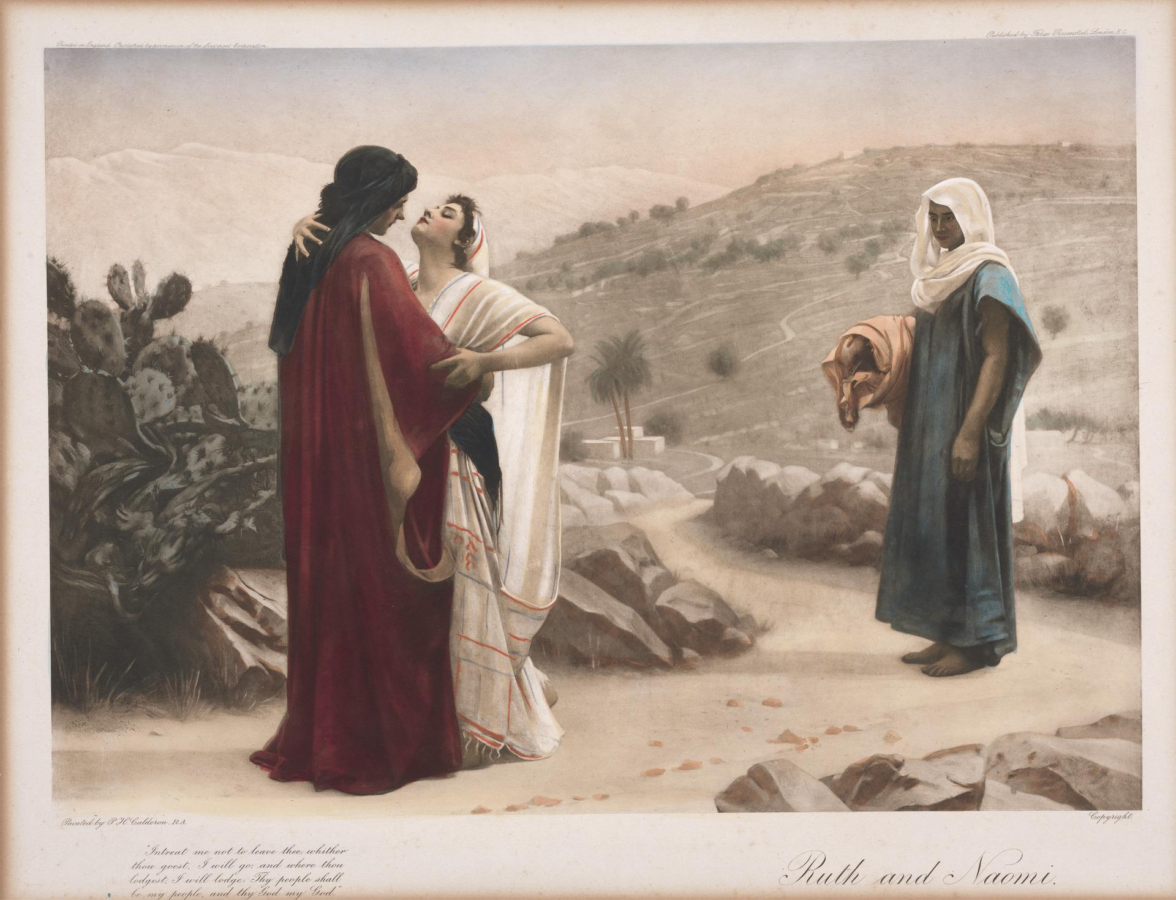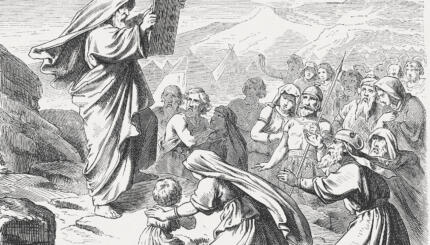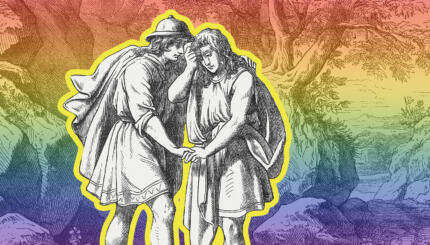Ruth is a book for all times, whether written in post-exilic days or based upon very old oral traditions. It is set in the time of the judges — not the best ones, if we assign it to the period of Gideon and Samson — and it attempts to define the rights of widows and aliens within a society fallen upon hard times.
Read the full text of the Book of Ruth in Hebrew and English on Sefaria.
The Book of Leviticus comes to life here, with its injunctions to leave part of the harvest for the needy, and with all of its concern and compassion for the underprivileged within the society. The text contains complexities; yet these fade away against the simple message of a Divine plan fulfilling itself among decent people: Ruth, Naomi and Boaz all occupy the stage in turn, and God‘s purpose is fulfilled through their actions.
We read the Scroll of Ruth on Shavuot, the time of the Giving of the Law. The authority for this is found in Soferim (xiv, 3-5) an eighth-century Palestinian text; and the rabbis find many reasons why Ruth and are linked: harvest time, the Giving of the Torah and its acceptance as we see it in the life of Ruth and David, the offspring of Ruth, who died on Shavuot; and it is a happy book for a season of joy.

Help us keep Jewish knowledge accessible to millions of people around the world.
Your donation to My Jewish Learning fuels endless journeys of Jewish discovery. With your help, My Jewish Learning can continue to provide nonstop opportunities for learning, connection and growth.
The Story Opens: A Low Point
The opening paragraph (Ruth 1:1), with a marvelous economy of words, sets the stage: The characters are presented, the situation is clear. Elimelech, Naomi, and their two sons become refugees in an alien land, losing all rights and status in fleeing from a famine — a major disaster in their homeland. Mahlon and Chilion have a role to play in the story. “Sick” and “Ailing,” (the literal meaning of their names) as their names describe them, they are still paired against one another. Mahlon’s name will survive through Ruth; Chilion disappears from view.
Even then, rabbinic imagination makes Orpah (Ruth’s sister-in-law) the ancestor of Goliath who will meet Ruth’s descendant, David, in a final confrontation of these branches of the family. Elimelech and the sons die. The rabbis see the death as caused by their leaving of Canaan. In this they touch on a clear theme within the book: the love for this land, a rich and sensuous feeling rising out of the story and out of the loving descriptions of the land at harvest time. Naomi returns to Bethlehem, the “sweet one” made “bitter” by adversity.
Ruth’s Declaration of Loyalty
Ruth remains with Naomi, while the realistic Orpah accepts Naomi’s reasoning that the daughters‑in‑law need not become refugees in turn. The text needs no embellishments:
Entreat me not to leave you, or to return from following after you. For wherever you go, I will go. Wherever you lodge, I will lodge. Your people shall be my people, and your God my God. Where you die, I will die; and there will I be buried…
It is a statement of loyalty and faith which endures through all generations. And the loyalty is soon put to the test, as Ruth goes out to glean in strange fields. There, in the field of Boaz, several patterns converge. Naomi has a plan which will obligate the kinsman to support her. Ruth has her own ideas which will, if realized, change her own position as well. And Boaz moves from an initial position of utter correctness and minimum courtesy to a granting of extra privileges which reflect a change within himself of which he is not fully aware at this point.
Boaz’ Kindness
Boaz acknowledges Ruth’s right to glean behind his handmaidens and to remain unmolested in his fields, but he does not yet accede to her request to glean among the sheaves. By meal time, he is a changed person: She is to eat with him, she may glean among the sheaves, and his men are to drop part of their harvest for Ruth to acquire. Ruth returns home with “an efah of barley” (between 30 and 50 pounds according to modern authorities), and Naomi realizes that their future might be brighter than she had dared to hope.
The harvest comes to an end, and Naomi instructs Ruth in a new plan: She is to join Boaz at the threshing floor during his night of vigil. The vigil had cultic and ceremonial significance; and Ruth’s preparations for the night are preparations of marriage. Whether or not the marriage was consummated on that night is debated, although the story is clear enough here: The consummation took place after the marriage (4:13) and was blessed by God with a son, Obed.
The Redeemer
The whole thrust of the narrative, of Boaz as “the redeemer,” of Obed declared to be the son of Naomi, would lose its point had the relationship between Ruth and Boaz been other than a proper marriage between equals. The court scene, between Boaz and the other unnamed claimant, establishes this as it resolves the underlying patterns with a happy ending. And time and history place another dimension into this pattern: the covenant of love between Boaz and Ruth reminded the people Israel, in times of exile and need, that a similar covenant exists and continues between Israel and God.
All of the story is brought to a successful conclusion. First, there is the matter of redeeming Elimelech’s property, Naomi’s only possibility of reestablishing herself in the land. The anonymous kinsman is anxious to purchase the land. Since Naomi has no male descendants, the property would then become part of his permanent family holding. Then Boaz reminds him that marriage to Ruth would be part of the obligation. The son of that marriage would be assigned to Naomi, and the final outcome of the contract would see the land revert to Naomi and her family. The kinsman demurs, and Boaz happily accepts the privilege and obligation of marrying Ruth and raising a family for Naomi.
Professor Herbert Brichto points out that the welfare of the dead depended upon descendants retaining ancestral property, and that the unknown kinsman had no desire to raise a son who would continue Mahlon’s name. The irony is clear: It is the kinsman whose name is forgotten!
The Unfolding of a Divine Pattern
The Scroll of Ruth is not a legal document giving instruction on levirate marriage and land redemption. As Jack Sassoon has pointed out, it is a folk tale, with the structure and logic of the storyteller’s art. It takes the legalities of the time for granted, as incidental to the unfolding of a Divine pattern within human lives, in the creation of a family tree for King David, with possible intimations of a messianic kingdom. It began with the suffering of Naomi, and ends with her joy. The declaration of Ruth is fulfilled: The destinies of Naomi and Ruth are interlocked, they are now one family and one faith. Boaz has fulfilled both of their hopes; he has been the redeemer to Naomi, the true husband to Ruth. And the community rejoices.
Chesed (Steadfast Kindness) Trumps Status
Some scholars have argued that the book was written to defend intermarriage. It was, they contend, a kind of tract put out against the demand made by Ezra on the return from exile that Jews who had remained in the land must divorce their non-Jewish wives. Certainly, it gives full rights to a Moabite woman who then becomes the ancestress of the royal house of the Jewish people, of King David who comes to represent the messianic ideal, the unity and peace which will embrace all humanity
Loyalty to the faith of Israel is fused with the love of humanity for whom the was revealed. As this text becomes part of Shavuot, the festival of that revelation, the convert who joins Ruth freely, with all her love and loyalty given freely, stands before Sinai and receives the Torah…
Rabbi Zeira said:
This scroll is not concerned with either purity or defilement, either prohibition or permission. Why,then, was it written? To teach you of a magnificent reward to those who practice and dispense chesed (steadfast kindness). (Ruth Rabba, 2:15)
Placed into our liturgy, at the season of the giving of the Torah, we thus rediscover the heart of the matter: the steadfast love, the chesed, which assures the eternity of the covenant made at Sinai between God and Israel to the commemoration of which we devote the festival of Shavuot.
Excerpted with the permission of CCAR Press from The Five Scrolls: Hebrew Texts, English Translations, Introductions and New Liturgies, Herbert N. Bronstein and Albert H. Friedlander, eds.



